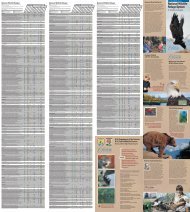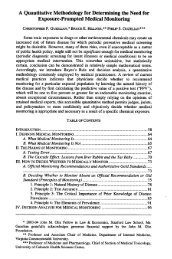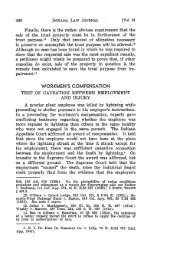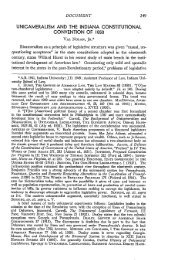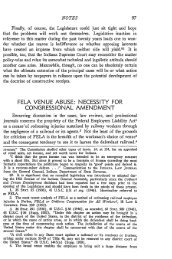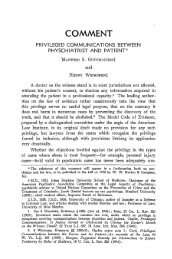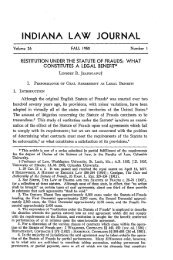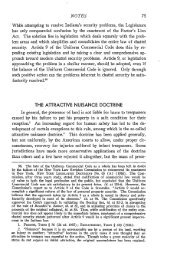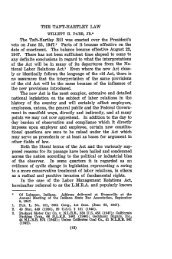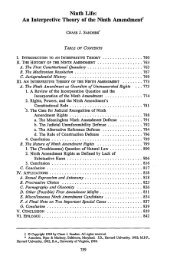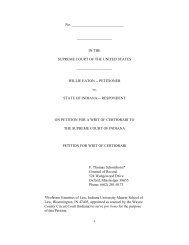Bridgeport Music v. Dimension Films - Indiana University School of ...
Bridgeport Music v. Dimension Films - Indiana University School of ...
Bridgeport Music v. Dimension Films - Indiana University School of ...
You also want an ePaper? Increase the reach of your titles
YUMPU automatically turns print PDFs into web optimized ePapers that Google loves.
2006] ALL MIXED UP 441<br />
compositions, especially in popular music.” 50 Such common themes do not meet the<br />
minimum threshold for originality, in the same way that a very simple sentence in<br />
English would not. Notes, like words, must be put together in an original way that<br />
requires a modicum <strong>of</strong> creativity.<br />
The originality requirement is particularly important in sampling cases. In Newton v.<br />
Diamond, 51 the district court found that the three-note sequence sampled by the Beastie<br />
Boys from Newton’s flute composition was not original in and <strong>of</strong> itself as a matter <strong>of</strong><br />
law. 52 Because the particular sequence was not original, the musical composition<br />
there<strong>of</strong> was not entitled to copyright protection, and the Beastie Boys could sample it<br />
with impunity. 53 Similarly, the defendants in <strong>Bridgeport</strong> <strong>Music</strong>, Inc. v. <strong>Dimension</strong><br />
<strong>Films</strong> 54 argued that the three-note sample at issue was a common sequence and<br />
therefore not entitled to copyright protection. 55 However, unlike in Newton, the alleged<br />
infringement in <strong>Bridgeport</strong> was <strong>of</strong> the sound recording (not the musical composition),<br />
leading the district court to conclude that while the notes themselves may have been<br />
unoriginal, the artist’s performance, as captured in the sound recording, was original. 56<br />
The opposing decisions <strong>of</strong> the two cases in regard to the originality issue highlight the<br />
fact that, depending on the subject matter <strong>of</strong> the copyright, there may be different<br />
characteristics to evaluate in order to determine if a work, or piece there<strong>of</strong>, is<br />
sufficiently original to merit copyright protection. 57 However, although originality may<br />
50. Gaste, 863 F.2d at 1068.<br />
51. 204 F. Supp. 2d 1244 (C.D. Cal. 2002), aff’d, 388 F.3d 1189 (9th Cir. 2004), cert.<br />
denied, 125 S.Ct. 2905 (2005).<br />
52. Id. at 1253. The court held that the musical composition was not original; although<br />
Newton’s performance may have been original, the issue in this case was infringement <strong>of</strong> the<br />
composition and not infringement <strong>of</strong> the sound recording, and therefore Newton’s unique<br />
performance style was irrelevant. See infra Part III.B.<br />
53. The court <strong>of</strong> appeals affirmed only on the ground that the use was de minimis. Newton,<br />
388 F.3d at 1190. The originality inquiry does inform the de minimis inquiry, however, in that<br />
typically a sample that qualified as de minimis would likewise be unoriginal, and therefore not<br />
entitled to copyright protection in the first instance. Nevertheless, it does not follow that a given<br />
sequence found to be unoriginal will necessarily be de minimis. See infra Part IV.B.<br />
54. 383 F.3d 390 (6th Cir. 2004), aff’d on reh’g, 410 F.3d 792 (6th Cir. 2005).<br />
55. <strong>Bridgeport</strong> <strong>Music</strong>, Inc. v. <strong>Dimension</strong> <strong>Films</strong>, 230 F. Supp. 2d 830, 839 (M.D. Tenn.<br />
2002) (noting the way the arpeggiated chord is used and memorialized in the “Get Off” sound<br />
recording), rev’d, 383 F.3d 390 (6th Cir. 2004), aff’d on reh’g, 410 F.3d 792 (6th Cir. 2005).<br />
56. Id. The court <strong>of</strong> appeals originally did not address the originality issue, except to say<br />
that it “would agree with the district court’s analysis . . . if the composition copyright had been<br />
at issue.” <strong>Bridgeport</strong>, 383 F.3d at 396 (emphasis added). The court <strong>of</strong> appeals concluded that a<br />
different analysis was required for sound recording copyrights, and “that the requirement <strong>of</strong><br />
originality is met by the fixation <strong>of</strong> sounds in the master recording.” Id. Of course, both fixation<br />
and originality are constitutionally required, and while a sound recording is by definition fixed,<br />
it is not by definition original. See supra Part I.B–C. Additionally, it seems clear that the district<br />
court adequately distinguished the fact that the copyright in question was <strong>of</strong> a sound recording.<br />
The court remedied the error in its subsequent order granting a panel rehearing, by amending the<br />
opinion to read simply “[w]e agree with the district court’s analysis on the question <strong>of</strong><br />
originality.” <strong>Bridgeport</strong> <strong>Music</strong>, Inc. v. <strong>Dimension</strong> <strong>Films</strong>, No. 02-6521, 2004 U.S. App. LEXIS<br />
26877, at *2 (6th Cir. Dec. 20, 2004).<br />
57. For the specific differences between a musical composition copyright and a sound<br />
recording copyright, see infra Part III.A–B.



